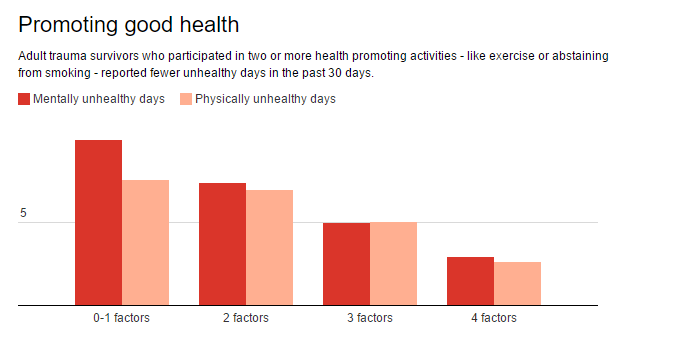The steps that can help adults heal from childhood trauma

Prevention is the mantra of modern medicine and public health. Benjamin Franklin said it himself: "An ounce of prevention is worth a pound of cure."
Unfortunately, childhood adversities such as abuse and neglect cannot be prevented by vaccinations. As we now know, a large proportion ofadultsgo through adverse childhood experiences (ACEs) and can exhibit symptoms such as substance abuse. The symptoms seen in adults can in turn expose the next generation to adverse outcomes – creating acycle that's hard to break.
However, we can limit the impact of ACEs on future generations by taking a close look at what we are doing today – not only for our children, but for ourselves, as adults. Therefore, to prevent adversities for children, we must addressthe healing and recovery of trauma in adults.
Shifting the paradigm
The ACE Study, launched in the 1990s, offered a groundbreaking look at how childhood trauma can impact health decades later.
More than two-thirds of the 17,000-plus adults in our study reported at least one ACE, such as divorce, neglect or domestic violence in the household. These adults were at a greater risk for numerous negative health and behavioral outcomes.
When I present this research, I often get questions about the adult survivors. What has helped these adults survive to tell their childhood histories?
The ACE Study was not conceptualized to examine resilience. But I had always been curious about what helped these trauma survivors thrive. I wanted to understand not only what led to their ill health later in life, but what led some of them to report positive health, despite their backgrounds.
Promoting good health
Modern medicine andpublic healthhave traditionally focused on figuring out the origins of disease and how to prevent poor health.
In 1996, medical sociologist and anthropologist Aaron Antonovsky offered a different perspective. He suggested we look at health as a continuum and focus on what can promotegood health. This approach, calledsalutogenesis, suggests that we as humans have the innate capacity to move toward health in the face of hardship.
Today, the World Health Organization defines health as "a state of complete physical, mental and social well-being and not merely the absence of disease or infirmity." I wondered how this approach might reflect on the adult survivors. What promotes their good health and positive well-being, knowing they are at risk for negative health conditions?

In 2013, my colleagues and Ipublished a studyexamining approximately 5,000 adults from the original ACE study who reported at least one childhood adversity. We focused on strategies that have been proven to promote good health – such as exercise, abstaining from smoking, access to emotional support and completing education at the high school level or higher.
Indeed, each of the factors listed was associated with reports of excellent, very good or good health among adult survivors. Depending on the factor, there was a30 to 80 percent increased likelhoodthat the adult would report positive well-being. Survivors who had a college education were 2.1 times more likely to report positive well-being than those with no high school diploma. These findings were after considering their chronic conditions. We also found that the four factors were associated with a lower likelihood to report depressive feelings.
When I repeated this study with a sample population of adult trauma survivorsfrom four states and the District of Columbia, I foundnearly identical results.
What's more, the greater number of health-promoting activities a person participated in, the better their well-being seemed to be. Adult survivors with at least two factors were 1.5 times more likely to report good to excellent health. Those who reported all four factors were 4.3 times more likely to report good to excellent health, compared to those who engaged in none or one, even after considering their chronic conditions.
On average, trauma survivors who reported at least two of the health promoting factors had also experiencedfewer mentally and physically unhealthy days in the past 30 days.
We have also learned that adult trauma survivors use complementary strategies such asyoga, massage, and dance therapy.
With that said, we need more rigorous studies to test these and other approaches that promote health and well-being. The studies presented examined only four factors and cannot be generalized to all adult survivors of ACEs.
How to start healing
From a survival perspective, the body can respond to perceived or actual threats with the"fight or flight"stress response. However, if this threat is constant, the endocrine and neuronal systems stay activated, which can overtax us and prevent the body from establishing homeostasis.Researchhas helped us to understand how disease can result from stress and trauma.
Just as we are biologically equipped with mechanisms to deal with threatening situations, our bodies are also equipped with neurochemicals like dopamine and GABA that provide feelings of security, happiness and motivation. We can ourselves activate these positive feelings through self-care. For example,in one study, massage was found to reduce cortisol and increase dopamine and serotonin.
There is no voodoo here. If we present our body and five senses with positive inputs – like calming music, unprocessed foods and walks through nature – we can stimulate our own system to regulate in a favorable way.
But these interventions may not be sufficient by themselves. Active counseling, the use of cognitive-behavioral therapy and in some cases medications or other health interventions may be needed.
We must recognize the strength and limitations of莫德n medicineand publichealthwhen it comes to addressing and preventing ACEs. Interrupting the cycle of abuse and neglect must first begin with adults. It will require anintegrativeand multigenerational approach that empowers individuals to heal their bodies, minds and spirits.
This article was originally published onThe Conversation. Read theoriginal article.![]()


















